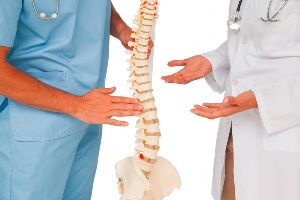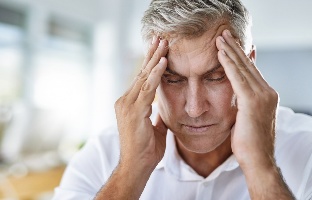
Many people associate the term "osteochondrosis" with old age. There is an opinion that it is a grandparent's disease that includes "low back pain" and "backache. "However, this confusion only has one grain of truth: in fact, osteochondrosis isdegenerative(which is caused by a local metabolic disorder)changes in the spine, whichEssentially appears in all elderly people. However, osteochondrosis occurs today in 9 out of 10 people out of 45, and the first manifestations of the disease can begin at age 25.
This disease is also called"disease of civilization", because the main cause of osteochondrosis is improper "exploitation" of the spine. The fact is that a modern person subjected it to excessive weight. , And, ironically, when he moves or lifts, but when he sits without getting up from the chair for hours. This load is calledstaticand is very difficult. Because oneThe person thinks that he is resting while he is sitting. But in reality, the spine works when sitting, with increased tension.
how spine works
To understand what osteochondrosis is, you need to understand what the human spine is. We all know that the spine consists of vertebrates that are connected in series by the intervertebral disc. In total, a person hasThere are usually 33–34 vertebrae: 7 of them make up the cervical region, 12 - in the axillary region, 5 (or a small percentage of 6 percent of people) - lumbar, 5 and vertebrae, growing together, form the sacrum. And finally, there are coccygeal areas. One and five (or four - depending on individual characteristics) vertebrae. Vertebrae are, in fact, bones, and they are stable, but so that they can move freely, our entire body. To provide mobility, and that they do not fall under the influence and friction, between each vertebra there is a layer of gelatinous substance (so-callednucleus pulposus) surrounded by strong multilayer plates (annulus fibrosus). Collectively, it is calledintervertebral disc.Also, the structure of the spine consists of many ligaments, vessels, nerves. It is a very complex organ that largely determines the function of almost all body systems, as it protects the spinal cord. Is and affects its work.

The vertebral and intervertebral discs are constantly renewed in a person's life. This is possible due to the fact that they are well supplied with blood and are always provided with good nutrition. , If, for some reason, nutrition starts to flow in the spine in insufficient amounts, the nucleus pulposus loses its properties, the intervertebral disc becomes flat and less elastic, cracks appear in the annulus, and the vertebrates themselves. Shifting in different directions and coming close to each other. All this leads to many dangerous deviations - mainlyboth in the spine and in the surrounding tissue, and for compression of the spinal cord and spinal cord.
It is interesting that such a concept as "spinal osteochondrosis" is predominantly present in the Soviet-posterior space. In foreign literature, changes in the spine are characterized by"hernias", "myofascial pain"", " Disc Injury ", " Dorsopathy ". So if you have heard something similar about yourself, you have osteochondrosis of the spinal cord. Such asintervertebral herniaFor, it is considered one of the stages of osteochondrosis.
is not an acute course of the disease and develops slowly: first, the intervertebral disc becomes nervous, then turns degeneratively, thenprotrusions appear- nucleus pulposusAre squeezed and mixed with fibrous ring, but do not rupture. When annulus fibroses rupture, they speak of anintervertebral hernia.Finally, the most severe phase of osteochondrosis, theintervertebral discs completely degenerate, the vertebrae start rubbing against each other and bone breaks, and bone growth and osteophytes. At the final stage, the spine is formed, as it was "petrified", that is, it loses its mobility, which can lead to disability.
Causes of Spinal Diseases
What causes all of the abovedegenerative changes?As already mentioned, the main reason isan abnormal weight on the spine:For example, when a person has to sit too much in an uncomfortable position, "hutch over", The cervical and thoracic regions experience stress and do not receive the necessary nutrition. In addition,osteochondrosis may develop due to poor posture.However,sports, especially strength sports, with violations of exercise technique, can also causedegenerative changes in the spine.
Another common cause is anyback injury. The development of osteochondrosishereditary genetic predisposition, hormonal disorders, excess weight, unhealthy diet, inadequate water intake and, as a result, dehydration, Smoking and alcohol abuse can be affected.
Women often encounter the first manifestations of osteochondrosis during pregnancy, then, when young mothers have to feed their baby in an uncomfortable position for themselves and often carry it in their arms, the spine becomes worse. She goes.
osteochondrosis symptoms
The symptoms of osteochondrosis are varied and depend on the exact department in which the disorder occurred. Pain is the main manifestation of this pathology, however, unlessrupture of annulus fibrosit is debilitating, it can be tedious. Is, can give pressure, and even patients cannot pay attention to it.More often the pain intensifies in the morning or after physical exertion, radiating to the arms, legs, neck, ribs, and chest (in this case, osteochondrosis can easily be confused with coronary heart disease).
Also,numbness and tingling may appear in organs.
With osteochondrosisin the cervical spine, headache may appear, sometimes very severe, dizziness, nausea, whistling in the ears. Development of a hernia, leading to compression of nerve endings, affected. Can cause disruption in the work of the internal organs associated with the nerve. For example, with a hernia in the lumbar spine, problems with urination may appear, strength may disappear, in the chest - indigestion, in the cervix -Problems with the blood supply to the brain.

Diagnosis of osteochondrosis
Only a doctor can distinguish osteochondrosis from other diseases of the internal organs and determine the source of pain. Today, magnetic resonance imaging is considered the most reliable method for diagnosing spinal diseases.
X-rays are also reliable, but less informative. On an X-ray, you can see changes in the intervertebral discs, but you cannot see, for example, the hernia and the position of the spinal cord and the displaced. One can assess its degree of compression by vertebrates. In addition, MRI allows you to distinguish osteochondrosis from other dangerous diseases, including malignant tumors and Becher's disease.
Is it possible to cure osteochondrosis?
Unfortunately, it is impossible to cure osteochondrosis, but it is possible to reduce the patient's condition andprevent further destruction of the intervertebral disc, however, it is necessarycompletelyChanging the way of life - Physical therapy - Swimming, massage or manual therapy, start eating right and quit bad habits. Sports, massage, proper nutrition, and weight loss can have significantly more and long-term medical effects than medications. is.
Doctors still argue about the effectiveness of chondroprotectors - drugs that restore cartilage tissue and, reportedly, strengthen the annulus fibros, have not proven their effectiveness adequately, but sinceThey certainly do not cause harm, so they can be used to treat osteochondrosis.
For severe pain, your doctor may prescribe non-steroidal anti-inflammatory drugs (NSAIDs), muscle relaxants (muscle relaxant medications) and analgesics.
Used in the treatment ofosteochondrosis andvitamins, as well as their deficiency provokes further destruction of the intervertebral disc:B vitamins, for example, of tissues. Beech helps to improve protein metabolism. Protein is the main building material in the body, then normalization of protein metabolism contributes to the restoration of nerve and cartilage tissue. Vitamin A improves blood circulation. However, taking vitamins, Like any other drugs, you need to be careful, as they can cause serious adverse reactions, and they can only be taken and consulted by a doctor.
Surgical treatment of osteochondrosis is also possible, but, as a rule, it is used when there is significant contraction of the spinal canal and results in excessive compression of the nerves and spinal cord by hernias. / zxb>. In this case, the condition is so difficult that the patient, for example, cannot walk, his internal organs begin to fail, or there is a risk of developing a stroke. Most commonly, such severeThe results are due to osteochondrosis of the cervix and lumbar spine, degenerative changes in the thoracic spine, even in the presence of hernia, almost never require surgical treatment.
Today,so-called sparing surgery methodsare being actively introduced into medical practice when doctors use a part of the nucleus pulposus using theendoscopeRemoval manages to preserve the integral structure of the vertebrae. The device is inserted into the skin through small incisions at the site of the spinal cord lesion, which avoids large blood loss. During the operationThe entire disc is not removed, the biomechanics of the spine are usually not disturbed, and it shortens the recovery period. Often, patients get up on their feet only one day after the operation. However, any spinal cordThe surgery is still fraught with complications and subsequent remnants of the disease, so experienced specialists will try to delay the finalization of the surgical treatment. And here everything depends on the patients themselves: if they are taking all the recommendations of the doctorsFollow up and take care of their health, even in the presence of hernias, they will be able to do without surgery.

















































